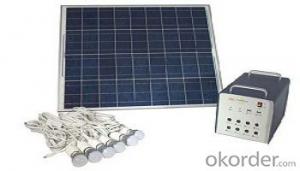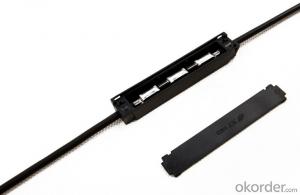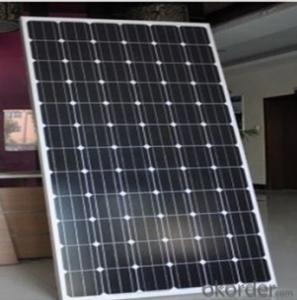Portable solar power system+500W Modify sine wave+34W Solar panels
- Loading Port:
- Shekou
- Payment Terms:
- TT OR LC
- Min Order Qty:
- 10 unit
- Supply Capability:
- 5000 unit/month
OKorder Service Pledge
OKorder Financial Service
You Might Also Like
Functions
1.The solar power system designed to provide DC power and AC power ,supply for lighting, mobile phone charging, run the
DC Fan and Radio, and TV ,computer etc.
2.Built-in PWM charge controller, real time display of battery capacity and load status.
3.Built-in maintenance-free Lead-acid battery.
4.With several output socket, can output voltage DC12V and USB DC5V at the same time.
5. Built-in DC to AC power inverter, can output AC220V/50HZ ,
6.Voice warning and together LED indicator shows the battery get low.
Technical parameters
| System voltage | 12V |
| Battery capacity | 20AH/12V |
| Max.charge current | 10A |
| Build-in solar panel Power | 38W, open circuit voltage:17.5V |
| Output voltage | DC output : DC socket: 12V/5A USB output: DC5V/800mA Cigar lighter: DC12V/10A Output AC : AC220V/50HZ |
| load power | DC Power: <120W (total power), AC Power:<500W |
| LVD (Low-voltage dis-cononect) | DC load LVD: 11.0V, AC load LVD: 10.0V |
| DC load re-connect voltage | 12.5V |
| HVD (High-voltage dis-connect) | 15.5V |
| Weight | 15KG |
| Dimension | 46*34*16 cm |
- Q:How does shading affect the performance of solar energy systems?
- Shading can significantly impact the performance of solar energy systems by reducing the amount of sunlight that reaches the solar panels. This decreases the overall energy production and efficiency of the system. Even partial shading on a small portion of the panels can lead to significant power losses, as solar panels are interconnected and work as a whole. Therefore, it is crucial to design solar installations in areas with minimal shading to maximize their performance and optimize energy generation.
- Q:How do solar energy systems affect property value?
- Solar energy systems can have a positive impact on property value by increasing the overall worth of a property. Research has shown that homes equipped with solar panels tend to sell for higher prices and at a faster rate compared to those without. This is because solar energy systems provide potential buyers with long-term cost savings on electricity bills and demonstrate an environmentally-friendly feature, which is increasingly appealing to the market.
- Q:What are the benefits of using solar energy systems?
- There are several benefits of using solar energy systems. Firstly, they are a renewable source of energy, meaning that they can generate electricity without depleting natural resources. Secondly, solar energy systems produce clean energy, as they do not emit any greenhouse gases or pollutants during operation, contributing to a healthier environment. Additionally, solar energy systems can help reduce electricity bills, as they provide a cost-effective way of generating electricity for homes or businesses. Finally, installing solar panels can also increase the value of a property and create job opportunities in the renewable energy sector.
- Q:Can solar energy be used at night?
- No, solar energy cannot be directly used at night as it relies on sunlight to generate electricity. However, energy storage systems such as batteries can be used to store excess solar energy during the day and provide power during the night.
- Q:Can solar energy systems be used in powering scientific research vessels or marine laboratories?
- Indeed, it is possible to utilize solar energy systems for the purpose of powering scientific research vessels or marine laboratories. Solar energy, being a renewable and sustainable power source, can be harnessed through the utilization of photovoltaic panels or solar thermal collectors. The energy requirements of research vessels and marine laboratories are substantial, given the nature of their operations which involve scientific experiments, data collection, and analysis. These activities usually involve the use of equipment like computers, sensors, and laboratory instruments, which necessitate a continuous and dependable power supply. To address this need, solar energy systems can be installed on said vessels or laboratories, providing a clean and efficient source of electricity. Through the conversion of sunlight into electricity via photovoltaic panels, the various equipment and systems on board can be powered. Moreover, any excess energy produced by the solar panels can be stored in batteries to be utilized during periods of decreased sunlight or at night. The utilization of solar energy in these marine environments presents numerous advantages. Firstly, it diminishes reliance on fossil fuels and diminishes the carbon footprint associated with conventional methods of power generation. This is particularly vital in the context of scientific research as it aligns with the principles of environmental sustainability and conservation. Secondly, solar energy systems offer a reliable and autonomous power source. Research vessels and marine laboratories often operate in remote or secluded locations where access to traditional power grids may be limited or non-existent. By harnessing solar energy, these vessels and facilities can generate their own electricity, enabling them to continue their research activities without depending on external power sources. Lastly, solar energy systems necessitate minimal maintenance and have a lengthy lifespan. Once installed, they require minimal upkeep and are capable of withstanding the harsh marine environment. This makes them highly suitable for use in research vessels or marine laboratories, where downtime and maintenance issues can be disruptive to ongoing scientific projects. In conclusion, there is no doubt that solar energy systems can be effectively employed to power scientific research vessels or marine laboratories. They offer a sustainable, reliable, and autonomous source of electricity, thereby reducing the carbon footprint and ensuring uninterrupted research activities, even in remote locations.
- Q:Are there any ongoing monitoring requirements for solar energy systems?
- Yes, there are ongoing monitoring requirements for solar energy systems. Regular monitoring is necessary to ensure that the system is functioning optimally and generating the expected amount of electricity. This includes checking for any performance issues, such as shading or malfunctions, and monitoring the energy production and consumption. Additionally, monitoring helps identify any potential maintenance or repair needs, ensuring the longevity and efficiency of the solar system.
- Q:Are there any risks of electrical short circuits with solar energy systems?
- Yes, there are risks of electrical short circuits with solar energy systems. Just like any other electrical system, solar energy systems can be susceptible to short circuits. A short circuit occurs when there is an unintended path of low resistance that allows a large amount of current to flow. This can happen due to various reasons such as faulty wiring, damaged components, or improper installation. Short circuits can result in overheating, electrical fires, or damage to the system. The high current flow generated by a short circuit can cause wires to melt, insulation to burn, and can even damage the solar panels themselves. In extreme cases, short circuits can lead to explosions or other serious safety hazards. To mitigate the risks of short circuits, it is crucial to ensure proper installation by qualified professionals who follow safety guidelines and adhere to local electrical codes. Regular maintenance and inspection of the system are also important to identify and address any potential issues. It is recommended to have a circuit breaker or fuse installed within the system to automatically disconnect the circuit in case of a short circuit. Additionally, the use of high-quality components and wiring that are specifically designed for solar energy systems can help minimize the risks of short circuits. It is also important to follow manufacturer's instructions and guidelines for system maintenance and operation. Overall, while the risks of electrical short circuits with solar energy systems exist, they can be effectively managed and minimized through proper installation, regular maintenance, and adherence to safety guidelines.
- Q:How much sunlight is needed for a solar energy system to be effective?
- A solar energy system can be effective with as little as 5 hours of direct sunlight per day, although the ideal range is typically 6 to 8 hours.
- Q:What is the impact of temperature on the performance of solar panels?
- The impact of temperature on the performance of solar panels is primarily negative, although there are some factors that can mitigate the effects. Generally, as the temperature increases, the efficiency of solar panels decreases. This is because the semiconductors within the panels become less effective at converting sunlight into electricity as they heat up. One of the main reasons for this decrease in efficiency is the relationship between temperature and the voltage output of solar panels. With increasing temperature, the voltage output decreases, leading to a reduction in the power output. This is known as the temperature coefficient of the solar panel, and it varies depending on the type and quality of the panel. Additionally, increased temperature can cause thermal expansion and contraction, which can lead to stress on the electrical connections and components within the panel. This can result in the degradation of the panel's performance over time. However, it is important to note that not all aspects of solar panel performance are negatively affected by temperature. In fact, higher temperatures can increase the conductivity of the electrical connections, which may improve the panel's overall performance. Furthermore, some solar panels are designed with cooling mechanisms, such as air or water circulation, to maintain their temperature and mitigate the negative effects. In conclusion, the impact of temperature on the performance of solar panels is predominantly negative, leading to a decrease in efficiency and power output. However, with proper design and cooling mechanisms, the effects can be mitigated to some extent, allowing solar panels to continue generating electricity even in high-temperature environments.
- Q:How does the location of a solar energy system affect its performance?
- The location of a solar energy system significantly affects its performance. Solar panels function optimally in areas with abundant sunlight and minimal shading. Regions with high levels of direct sunlight, such as deserts or open plains, are ideal for maximizing solar energy production. Additionally, the tilt and orientation of the panels should be optimized to capture the most sunlight throughout the day. Factors like latitude, climate, and local weather patterns also play a role in determining the efficiency of a solar energy system. Ultimately, choosing the right location can greatly enhance the overall performance and output of a solar energy system.
1. Manufacturer Overview |
|
|---|---|
| Location | |
| Year Established | |
| Annual Output Value | |
| Main Markets | |
| Company Certifications | |
2. Manufacturer Certificates |
|
|---|---|
| a) Certification Name | |
| Range | |
| Reference | |
| Validity Period | |
3. Manufacturer Capability |
|
|---|---|
| a)Trade Capacity | |
| Nearest Port | |
| Export Percentage | |
| No.of Employees in Trade Department | |
| Language Spoken: | |
| b)Factory Information | |
| Factory Size: | |
| No. of Production Lines | |
| Contract Manufacturing | |
| Product Price Range | |
Send your message to us
Portable solar power system+500W Modify sine wave+34W Solar panels
- Loading Port:
- Shekou
- Payment Terms:
- TT OR LC
- Min Order Qty:
- 10 unit
- Supply Capability:
- 5000 unit/month
OKorder Service Pledge
OKorder Financial Service
Similar products
New products
Hot products
Hot Searches
Related keywords































